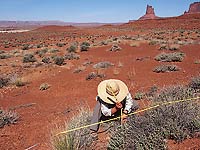Science HAPPENINGS June 2019 |
||||||
| Recovering from Drought: Monitoring Plant Health in the National Parks by Dana Witwicki |
||||||
Due to a long, intense drought, 2018 was a tough year for plants in Southeast Utah. Some of the worst conditions were at Natural Bridges National Monument, where precipitation was below long-term averages for 16 consecutive months. Further north, rare showers punctuated intensely dry conditions near Arches and Canyonlands national parks, but the landscape remained parched. Drought can have major effects on the plant communities that anchor park ecosystems. From an office in Moab, a group of National Park Service (NPS) scientists helps park managers know what kinds of changes are happening. Each spring for the past 10 years, they have collected data that reveal the health of grasslands, blackbrush shrublands, and pinyon-juniper woodlands at Arches and Canyonlands. By looking at changes in the number and cover of live plants, we can assess whether they are thriving or declining. Compiling a long-term, place-based record helps us understand how plant communities respond to climatic events (like the recent drought), and which species, locations, and soils are most vulnerable or resilient. Park managers use this information to make decisions about which species to restore, and which exotic-plant populations to target for removal.
Many shrub species, with their deep roots and woody stems, fared better. They’re greening back up after the wet winter and spring. If you look closely, you’ll see tiny shrub seedlings that have germinated all over the desert. Scientists will continue to observe the recovery of these plants and learn more about regional drought effects. Along with dryland plant communities, the NPS Northern Colorado Plateau Network also monitors the health of soils, riparian plants, rivers, streams, and springs on the Colorado Plateau. For more information on our work, or to download species lists for parks in the area, visit https://www.nps.gov/im/ncpn/. |
||||||


